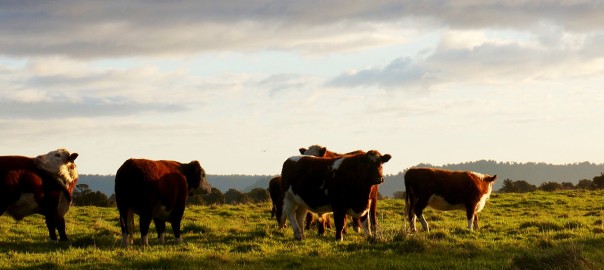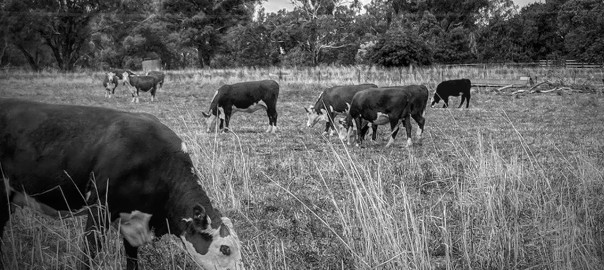Humanely-raised meat — ethically, pasture-raised with sustainable farming practices involved — is of higher quality than standard, factory-farm meat for a number of reasons. Most importantly, animals live better when raised by ethically-minded farmers and ranchers.
It’s important that animal health is considered in every step of the lifecycle. Their natural tendencies should be honored: Cattle should be able to roam, hogs graze, and chickens should be raised on pasture.
When it comes to understanding humanely-raised meat, it is good to get a grasp of the decisions made by family farmers for whom animal welfare is a top priority. Was the animal healthy and content? Was it ever administered antibiotics or hormones? Farms and company facilities should operate with best practice s— for example, Dr. Temple Grandin’s livestock principles.
Below, we detail ethical practices for farming and processing grass-fed and finished beef, heritage-breed pork, and organic, free-range chicken.
Grass-fed, grass-finished beef
Only one percent of the total beef consumed in the United States is 100 percent grass-fed and grass-finished. American beef that meets that standard comes from cattle that were free to roam on pasture throughout their entire lives, nursing from their mother for six to nine months, and then grazing on a natural diet of grass. Grass-fed and grass-finished cattle — usually only referred to as grass-fed — consume only grass for the entirety of their post-nursing lives, while grain-fed cattle may have been supplemented with grain or corn or finished with grain.
Grass-fed cattle feed on annual and perennial grasses, forbs—herbaceous flowering plants—and cereal grain in a pre-grain state. Grass-fed cattle graze year-round, with access to shelter when needed.
This is in contrast to grain-fed cattle, which constitute the vast majority of beef consumed in the United States. Grain-feeding cattle is a relatively recent development; animals throughout most of history were free to roam and eat grass.
While grass-fed cattle roam freely in the fresh air, grain-fed cattle are moved to concentrated feedlots. They’re fed a grain-centric diet based on soy or corn and put on weight more rapidly than pasture-raised cattle. They are often treated with antibiotics and hormones to maximize growth. A vast majority experience very poor living conditions their entire lives.
Beyond concerns about the life of the animal, grass-fed beef also offers major health benefits to the consumer. Typically leaner, it’s less fatty and caloric. It boasts more heart-healthy omega-3 fatty acids than grain-fed beef, more antioxidant vitamins and more healthy fats that might reduce chronic diseases.
While the animal’s food source is crucial to its quality, it’s equally important to ensure that the animal is humanely raised. In order to be certified humane in the United States, the animal can never be confined for intensive feeding. It must have access to adequate grazing pasture. It can only be confined for no more than 20 days a year for animal management, like husbandry or treatment.
A majority of the grass-fed, grass-finished beef on the market comes from Australia, which has very high animal welfare standards as well as the climate and pasture land to allow cattle to spend their entire lives grazing.
Heritage-breed pork
Berkshire, Chester White, Duroc—have you heard of these breeds of pig? They belong to a class known as heritage-breed pork. Traditionally bred for food, these breeds of pig dwindled in numbers during the rise of industrial agriculture. Heritage-breed pigs are better adapted to withstand disease and live in open pasture. Unlike factory farmed pigs, heritage-breed pigs are not treated with antibiotics, hormones, and don’t live in temperature-controlled indoor units. They possess unique genetic traits and are raised on sustainable farms.
In order to be considered certified humane, these pigs are not subjected to farrowing and gestation stalls. Gestation stalls enclose sows during pregnancy, while farrowing stalls pen sows in while nursing piglets. Just as with cattle, there are no concentrated feeding operations. While conventionally farmed pigs typically have slatted floors in their environments—proven to increase leg problems for pigs—heritage breed pigs are raised on farms without slatted floors.
Perhaps the best part about heritage-breed pork is its delicious, succulent flavor. Heritage-breed pork is more marbled than conventionally-farmed pork, meaning juicier, more flavorful meat.
Some breeds take a bit of time to get to market weight, but they’re so delicious, they’re worth the wait.
Organic, free-range chicken
Chickens given regular access to the outdoors, rather than being kept in heavily confined conditions, are much happier than their factory-farmed counterparts.
These birds are called free-range chickens. They have access to as much outdoor space as they do indoor space, including special enhancements like hay bales and places to climb. They roost in barns and roam in and out as they please, interact with other chickens, and live as nature intended. This results in a stress-free, cage-free, happy life for the chicken. The quality of your meat, in turn, is much higher.
In addition to free-range, higher quality chickens should be antibiotic and hormone free. Unfortunately, factory-farmed chickens are usually subjected to an array of antibiotics. Hormones, however, are prohibited across the industry.
Chickens fed vegetarian diets from both foraged and feed sources tend to be healthier. Additionally, free-range chicken often forage for bugs, grubs, and the like, which is exceptionally healthy for them. With non-genetically modified grain diets and pesticide-free growing environments for the feed, these chickens qualify as non-GMO and organic. Plus, in addition to being humanely-raised and healthier for you, they taste delicious.







